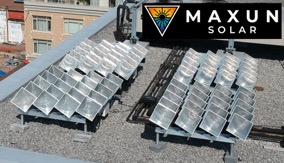Ottawa-based MAXUN Solar (formerly CoGenerate Solar) provides a low-cost path to achieving net-zero emissions for buildings by offsetting both electrical and thermal loads. We spoke to Ra’ed Arab, Founder and CEO, to learn more about his interest in maximizing the power of the sun.
Describe your core technology(ies). What makes your solution different than anything else on the market? How is your company contributing to a cleaner, greener future?
MAXUN Solar maximizes solar energy capture through dual-axis tracking technology for buildings with photovoltaic, thermal, or combined generation. We developed the first low-profile dual-axis sun tracking system for flat rooftops, which increases the output of any photovoltaic technology by a minimum of 50% with a lower levelized cost of energy compared with a fixed tilt system. Looking at the global emissions picture, buildings account for 31% of all emissions. Combined with other technologies, we can help bring buildings to net-zero emissions, or close to it.
Other than coffee, what gets you out of bed in the morning? How does this work connect with your core beliefs and values?
I was born in Kuwait, one of the world’s hottest places. Since I was young, I’ve thought about the sun as a resource. I’ve always been motivated to work on the challenge of maximizing solar energy. Our team at MAXUN is equally passionate about making an impact on environment and humanity. We’re excited to offer solar solutions that deliver less expensive and more efficient energy for multi-level buildings and make net-zero emissions achievable.
Tell us about a recent win (or wins) or your company.
MAXUN is in the final stage of signing our first strategic agreement to supply our products to one of Canada’s largest energy companies. It is a win-win-win-win story, where we win with increased business, our partner has a new path to supply green energy instead of the current carbon-based options, end users win by reducing their carbon footprint and achieve net zero and decrease their energy costs, and Canada and world win by reaching the targets set in the Paris Agreement.
What’s next for your company?
We’re working on commercializing our first product, the iPyramid-1P, a rooftop PV dual-axis sun tracking solution, and planning a market launch in Canada. We then plan to expand our offering through our partners, distributors to North American, and to the rest of the world.
Finally, what’s on your team’s wish list for Ontario’s cleantech sector?
We need government support to assist solar companies as we all put Canada on the solar manufacturing map. This includes facilitating regulations that encourage business and industry to adopt technologies, implement going green, and reach zero-carbon. We also need government to be early adopters of Ontario cleantech solutions. They don’t have to be large, but they need to happen quickly and with minimal red tape. This will build the province’s technology sector, create skilled jobs, make use of our advanced manufacturing technologies and firms, and generate tax dollars.
Get to know #ONcleantech! Each month, OCTIA will profile a different member company or organization. Want more Ontario clean technology content? Subscribe to our newsletter.

